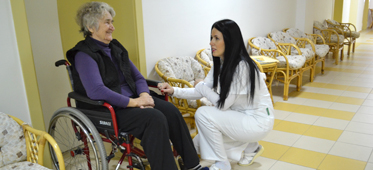Milder damages of the central nervous system
Conditions after strokes

Acute stroke (brain infarction, insult, brain attack) is a condition which occurs due to occlusion of the blood vessel (acute ischemic stroke 75-80% of patients) or due to blood vessel rupture when it bleeds into the surrounding brain (acute hemorrhagic stroke 20-25% of patients).
In our country, acute stroke is at the first place as a cause of death in women, while it takes the second place in men. Except the fact that this is a disease with very high rate of mortality (mortality rate in the first month is up to 23%), this is also a neurological disease with the highest invalidity rate and with the highest percentage of repeating (every third patient experiences stroke in 5-year period).
Risk factors for stroke which can be influenced include: increased blood pressure, diabetes, heart conditions, blood lipid disorders, overweight, smoking, physical inactivity, diet, misuse of alcoholic drinks.
Symptoms indicating stroke include: sudden weakness, paralysis and/or numbing of one body half (face, arm, leg), sudden confusion with speech impediments, sudden vision impairment, sudden walking disability, dizziness, balance loss, suddenly developed headache, usually accompanied with nausea.
Each patient suffering stroke should be brought to the nearest health institution immediately.
Early rehabilitation in these patients is applied from the very beginning of the disease aiming to prevent development of complications in some other systems (pneumonia, deep vane thrombosis, lung embolism, decubitus, joint stiffness). After a month, rehabilitation continues in some specialized rehabilitation center.
Direct goals of rehabilitation are as follows:
- to train a patient to walk again, independently or with some aid
- to train a patient to use the upper injured limb (arm) as much as possible in his/her everyday activities
- to train a patient to execute activities necessary in everyday life (eating, washing, bathing, shaving, dressing).
The rehabilitation program is adjusted to each patient individually. Physical procedures we apply include kinesitherapy (exercises), occupational therapy, manual or underwater massage, baths for arms and legs, paraffin therapy, electric and magnetic therapy.
The treatment lasts from one to three months depending on functional condition of a patient. Successfulness of recovery is the highest in the first year.
Stroke tends to repeat, and therefore secondary prevention is of a great importance (control of increased blood pressure, increased cholesterol and sugar in blood, regular administration of prescribed medicines, regular visits to your physician, quitting bad habits – smoking, unhealthy diet, alcohol consumption).
